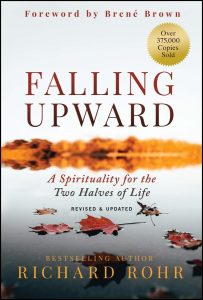 Summary: A look at the process of change as we age and mature.
Summary: A look at the process of change as we age and mature.
I am in a Tuesday morning book group at my local Jesuit retreat house. The group meets for about 8 to 10 weeks twice a year. There are about 20 people who are involved, usually about 15-16 people a week are present. Because the group meets at 10:15 AM on a Tuesday, it is mostly people who are retirement age. The group is primarily Catholic and female, although not entirely. I very much value the group and I will continue to read whatever the group picks. But I was not looking forward to reading Falling Upward. I have previously read it twice in 2011 and in 2016. I liked it less each time I read it. But there is something helpful about reading a book in a group because you gain the perspective of others as you read it. I tend to like books less if I previously liked them when rereading them in a group. But I also tend to like books more when rereading with a group if I didn’t like them previously. In both cases, it is because different perspectives give me insight into aspects of the book that I did not have when reading alone.
Part of what I found interesting is that about a third of the group was new to the book. But most of the group had read it two or three times previously. Almost everyone who found the book valuable had read it multiple times. I continue to think that Rohr is less clear than he should be. And I continue to think he is trying to read too large of an audience. I both found the book more helpful and more limited with this reading.
On the negative side, I think that his use of the archetype narrative (The Oddesy and other similar stories) has the problem of orienting the discussion of the second half of life in a male-oriented way. I know Rohr is a Catholic priest and a man, but over and over again, I found his illustrations and framing to be overly limited. One of the main themes of the book is how part of maturity is rejecting false dualism and embracing the Both/And. But then he would create evaluative dualism between the first and second half of life. I probably can’t be Rohr, but I would like to see someone else write about archetypal narrative in a similar way, but add in many more illustrations that are rooted in female archetypes.
On the positive side, I do think that reading this nearly 15 years after the first reading I have more life experience and maturity and I can see areas where I can make sense of his point in ways that I couldn’t before. But I also think that there are many areas where he will continue to be misunderstood either because he was not clear or because the audience that is reading isn’t who he was addressing. Over and over again, I ran into comments or advice or illustrations where it made sense, but there was a level of health that is assumed that may not be present. This is similar to my complaints about A Loving Life by Paul Miller. Miller calls on people to tolerate suffering and abuse to lead others toward repentance but does not spend nearly enough time talking about the reality of abuse and the harm that comes about because of abuse. There were many places where the advice or illustration works in one setting, but not in another. That discernment of how to apply wisdom like this requires a level of maturity that I am not sure applies to everyone reading the book.
I am glad I read it again, at least I was glad that I read it with the group. I do not think it is an essential book.
Falling Upward: A Spirituality for the Two Halves of Life by Richard Rohr Purchase Links: Paperback, Kindle Edition, Audible.com Audiobook